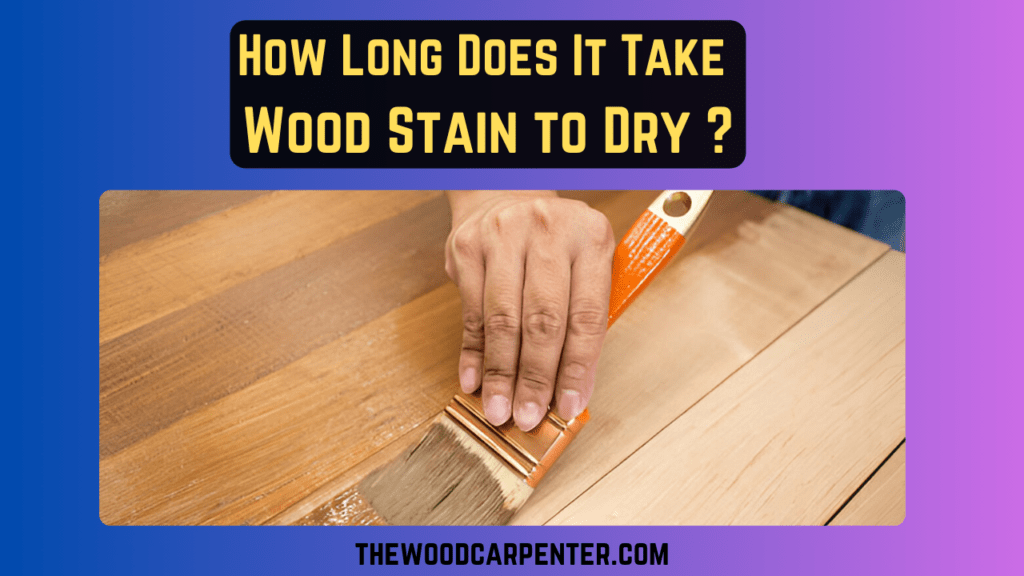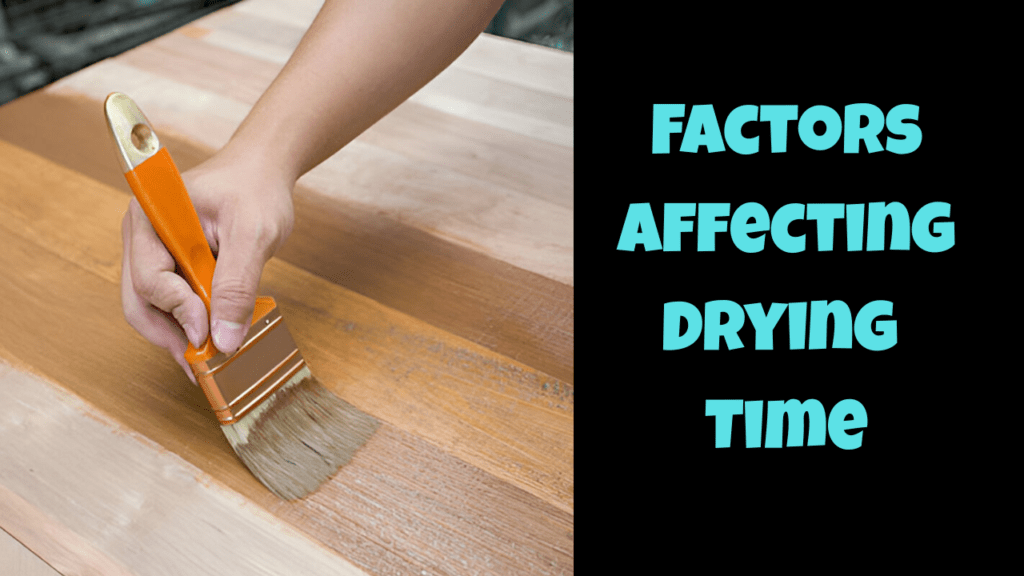
Wood stain is a key element in woodworking, used to change the color of wood, enhance its appearance, and provide protection. One crucial aspect of this process is understanding how long it takes for the stain to dry.
The drying time of wood stain influences the final look of the wood, its durability, and how soon you can proceed with the next steps, like adding a sealant or using the finished piece.
In this article, we will explore the factors that impact drying time, the various types of stains and their drying durations, tips for achieving better results, and answers to frequently asked questions.
The Importance of Understanding Drying Time
Knowing how long wood stain takes to dry can save you time and effort—whether you’re fixing furniture, staining a deck, or finishing a custom table. How fast it dries depends on things like the type of stain, the condition of the wood, and the environment you’re working in.
Drying is important because it lets the stain soak into the wood properly and set evenly, giving you a strong and nice-looking finish. If you wait too long, your project gets delayed. But if you rush, you might end up with streaks, blotches, or sticky spots.
Factors Affecting Wood Stain Drying Time
Several factors affect the drying time of wood stains. The key characteristics are examined in detail here:
Type of Stains
Water-Based Stains
These stains dry fast—usually in 1 to 3 hours. You can put on another coat after 4 to 6 hours. It may take 1 to 2 days to fully cure, depending on the weather. They don’t smell much and are easy to clean with soap and water.
Oil-Based Stains
Oil stains dry slower. They feel dry after 6 to 12 hours, but it can take 1 to 3 days to cure fully. Warm, dry weather helps them dry faster. They soak into the wood and give a deep, rich color, but you need to wait longer.
Gel Stains
Gel stains are thick, so they take longer to dry—about 6 to 8 hours. It can take up to 3 days to cure. They’re great for vertical surfaces because they don’t drip easily.
Semi-Transparent Stains
These stains show the wood grain while adding some color. You can add another coat in 1 to 2 hours. Full curing can take up to 3 days.
Solid Color Stains
These stains cover the wood completely and protect it well. They dry in 4 to 6 hours, but curing takes around 3 days.
Factors Affecting Drying Time

Several things can affect how long wood stain takes to dry:
1. Type of Wood
Hardwood vs. Softwood: Hardwoods like oak or maple absorb stain slowly, so they dry slower. Softwoods like pine soak it up faster and dry quicker.
Moisture in the Wood: If the wood is wet or still has moisture inside, the stain takes longer to dry.
Smooth vs. Rough Surface: Smooth, sanded wood lets stain soak in evenly and dry faster. Rough or unprepared wood can slow it down.
2. Temperature
Staining works best when it’s between 50°F and 90°F (10°C to 32°C). If it’s too cold, the stain dries very slowly. If it’s too hot, it can dry too fast and look uneven.
3. Humidity
High humidity (moisture in the air) makes stain dry slower because it can’t evaporate as easily. Dry days are best for staining wood.
4. Airflow
Good air movement helps stain dry faster. You can open windows or use fans to improve air circulation.
5. How You Apply the Stain
Thin layers of stain dry much faster than thick ones. Thick coats can trap moisture and take a lot longer to dry.
Teak Oil vs Tung Oil: Which Wood Finish is Best for You?
Tung Oil vs Danish Oil: A Comprehensive Comparison
Average Drying Times by Stain Type
| Stain Type | Dry to Touch | Ready for Recoat | Fully Cured |
| Oil-Based Stain | 6–24 hours | 12–48 hours | 72 hours or more |
| Water-Based Stain | 1–2 hours | 2–4 hours | 24 hours |
| Gel Stain | 8–24 hours | 12–48 hours | 72 hours |
| Lacquer-Based Stain | 15–30 minutes | 1 hour | 24 hours |
Tips for Optimizing Stain Drying Time
If you want to ensure the best results and possibly speed up the process, follow these tips:
Use Drying Accelerators
- Space Heaters: Use them cautiously to keep the area warm.
- Hair Dryers or Heat Guns: These can be used for small areas, but avoid overheating the wood to prevent damage.
Choose the Right Stain
If drying time is a priority, opt for water-based or lacquer-based stains, which dry faster. For a richer finish, oil-based stains are worth the wait but require patience.
Control Environmental Conditions
- Maintain an indoor temperature of 65°F to 75°F if possible.
- Use a dehumidifier to reduce humidity levels.
- Improve ventilation with fans or open windows.
Apply Thin Coats
Applying thin, even layers of stain ensures quicker drying and better penetration. Wipe off any excess stain promptly after application.
Sand and Prepare the Wood
Sanding the wood evenly and cleaning it thoroughly removes dust, grease, or previous coatings that could hinder the stain’s absorption.
Curing vs. Drying
It’s important to understand the difference between “drying” and “curing.”
- Drying means the stain feels dry to the touch.
- Curing means the stain has fully hardened and stuck to the wood properly.
Drying happens faster, but curing can take much longer—sometimes several days or even weeks, depending on the stain and the conditions.
Real-Life Examples:
Example 1: Outdoor Deck
A homeowner stained their deck with an oil-based stain on a hot, humid summer day (around 85°F or 29°C). Even though they applied it correctly—thin coats and wiped off the extra—the high humidity slowed everything down. The deck took over three days to fully cure.
Example 2: Indoor Furniture
Someone stained a table indoors using a water-based gel stain. The room was cool, air-conditioned, and not very humid (about 40%). The stain dried in just two hours, and they could apply a second coat in four hours. This shows how working in a controlled indoor space can make things dry much faster.
Common Problems and Solutions
Sticky or Tacky Surface
Cause: Excess stain left on the surface.
Solution: Wipe off the residue with a clean cloth and allow more drying time.
Uneven Finish
Cause: Improper sanding or inconsistent application.
Solution: Sand and reapply the stain in thin, even coats.
Blotchy Appearance
Cause: Softwoods like pine absorb stain unevenly.
Solution: Use a pre-stain conditioner for a more uniform finish.
Conclusion: Take Your Time for the Best Results
Getting a smooth and long-lasting wood stain finish takes time. Things like the type of stain, the kind of wood, and the weather all affect how long it takes to dry—but the most important thing is patience. If you rush, you might end up with sticky spots, streaks, or blotchy areas.
To get a great-looking finish, just follow the right steps and let the stain dry properly. Whether you’re new to DIY or have done this before, waiting for the stain to dry fully will save you time and effort later.
FAQs
1. How do I know if the stain is dry?
Touch the surface gently. If it feels dry and not sticky, it’s ready. The color should look even and not smudge.
2. Can I add polyurethane before the stain is dry?
No. If you do, it can trap moisture and cause bubbles, peeling, or an uneven finish.
3. Why is my wood still sticky after 24 hours?
You may have used too much stain or didn’t wipe off the extra. Let it dry longer and wipe it with a clean cloth.
4. Can I stain wood when it’s cold?
It’s not a good idea to stain wood below 50°F (10°C). It dries too slowly. Try working indoors or wait for warmer weather.
5. Do I need to sand between stain coats?
Usually, no. But if the surface feels rough, you can lightly sand it with fine sandpaper.
6. How should I store wood while it’s drying?
Keep it in a clean, dry space with good airflow at room temperature. Don’t stack or place anything on it until it’s completely dry.